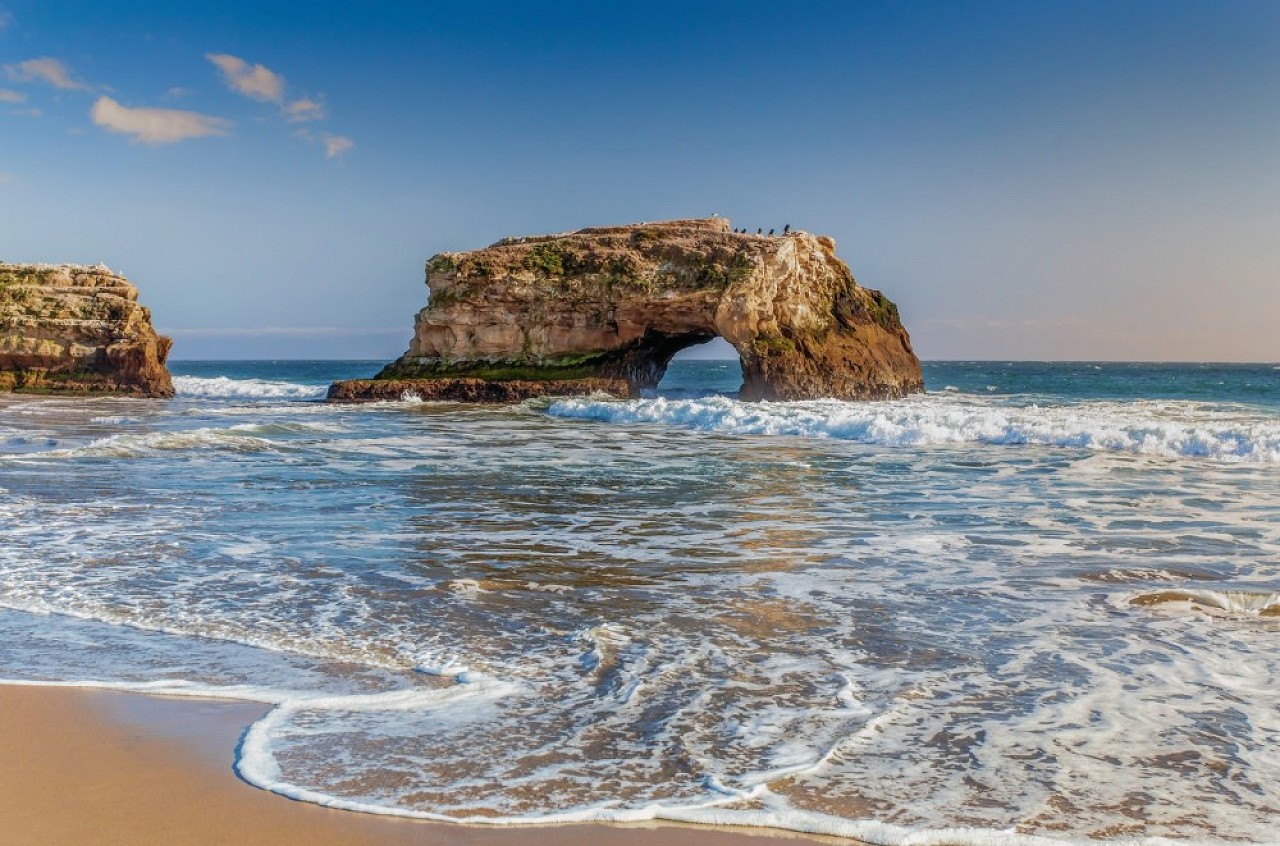


Natural Bridges State Beach is a 65-acre California state park in Santa Cruz, California, in the United States. The park features a natural bridge across a section of the beach. It is also well known as a hotspot to see monarch butterfly migrations.
This park and beach is an excellent vantage point for viewing shore birds, migrating whales, as well as seals and otters playing offshore. Further along the beach, public access tidepools offer a glimpse of life beneath the sea. Low tides reveal sea stars, shore crabs, sea anemones, and other colorful ocean life. The park also includes a large area of coastal scrub and grasslands, with bright native wildflowers in the spring. Moore Creek flows through the park, forming freshwater wetlands and a salt marsh before it reaches the sea.
The day use area is located a short drive up the park road. There’s accessible parking in the large lot, with level access over to the visitor center, and accessible family restrooms just outside the front door.
The Monarch Boardwalk is located to the right of the visitor center, across the service road. This .15-mile trail winds through a eucalyptus grove, and although it does have a slight downhill grade, there are level spots every 20-30 feet. That said, some manual wheelchair-users may need a bit of assistance on the uphill journey.
This is one of the top spots to find the overwintering monarchs, however it’s usually a hit or miss proposition. Weather plays a large factor in the presence and activity of the migratory monarchs, and you’ll probably strike out after a big storm or on a windy day. That said it is one of their favorite haunts. Even if you don’t spot any butterflies, the boardwalk still offers a very nice stroll through the grove. Additionally, it’s a great place for a picnic, as there are two accessible picnic tables on a concrete slab near the parking area.
The park's Monarch Grove provides a temporary home for thousands of Monarchs. In 2016, 8,000 Monarch Butterflies overwintered at Natural Bridges. From late fall into winter, the Monarchs form a "city in the trees." The area's mild seaside climate and eucalyptus grove provide a safe place for monarchs to roost until spring.
In the spring and summer, the butterflies live in the valley regions west of the Rocky Mountains where the monarch's companion plant, milkweed, is found. For most of the year, where there are monarchs, there are also milkweed plants. Monarchs drink nectar from milkweed flowers, and female monarchs lay their eggs on milkweed leaves. Milkweed contains a toxin that, when ingested by the caterpillar, makes it toxic to other animals. These toxins remain in the butterfly as well, providing protection from predators that would otherwise eat the monarchs.
Visiting the Monarch Preserve
Monarch migration is variable and population numbers and dates are different each year. The monarchs typically begin arriving in mid-October and leave by mid-February (In 2013, 2016, and 2017 the monarchs had left by January). At Natural Bridges, late October and all of November is often the best time to go for a walk and observe the monarchs. The Monarch Grove at Natural Bridges has been declared a Natural Preserve, thus protecting these butterflies and their winter habitat from human encroachment or harm. It is the only State Monarch Preserve in California.
The grove contains eucalyptus trees which are located in a gently sloping canyon, providing the Monarch needed shelter from the wind. These winter-flowering trees are also a convenient food source for the butterfly. On chilly days when the temperature drops below 60 degrees, the butterflies cluster together in the eucalyptus trees for warmth.
Visitors can view the over-wintering Monarchs by walking down the park's wheelchair and stroller-accessible boardwalk to an observation deck in the eucalyptus grove.
PICNIC AREA is located off the main parking lot in a eucalyptus and pine trees grove. Tables, barbecues, water faucets and restroom facilities are available. This is a day-use park only, there is no camping.
OCEAN SAFETY— No lifeguards on duty. Enter tide pools only during periods of low tide. Surf can be unpredictable. Hazardous rip currents and large waves can appear out of nowhere and sweep people out to sea. Do not run on the wet rocks of the intertidal area, and never turn your back to the waves. Check at the entrance station or visitor center before entering the ocean and the tide pool areas.
COLLECTING is not allowed—Do not disturb tide pool residents or the butterfly clusters in any way. The park’s plants, animals, and all natural and cultural features are protected by law.
DOGS are allowed only in the parking lots and picnic areas, but NOT on the beach and trails (except for service animals). All dogs must be on a six-foot maximum leash and under human control at all times. Please do not leave your dog unattended in a vehicle.
BICYCLES are permitted only on paved roads.
FIRES are not allowed on the beach.
GLASS containers are not allowed on the beach.
ALCOHOL is only allowed in the park with a previously issued special-event permit. Submit permit applications at least 30 days before the event date.
DRONES are not allowed in the park. To protect wildlife and cultural resources, and for the safety and welfare of visitors and staff, the park is closed to the use of Model Aircraft, Unmanned Aircraft Systems (UAS), and Gliders in flight.
Accessibility
Picnic Area
Two accessible sites and several usable tables are available. Restroom: Accessible restrooms are available at the visitor center. Parking: Accessible parking is available. Routes of travel are generally accessible or usable.
Trails
The Monarch Trail is an accessible interpretive boardwalk of about 0.13 mile. It has shaded areas and many rest or conversation areas, some with built-in benches. Trailhead is near visitor center. Van accessible parking, accessible restroom, picnic table and potable water are in main lot below Visitor Center.
Beach/Shore Access
Adjacent to the entrance station is a generally accessible viewing platform with benches that overlook the beach and the natural bridges. A beach wheelchair is available. Call (831) 423-4609 for information.
Exhibits/Programs
The visitor center is generally accessible and includes interactive displays, videos and a bookstore. Restrooms in the visitor center are accessible. Parking: Accessible parking is available at the visitor center.

